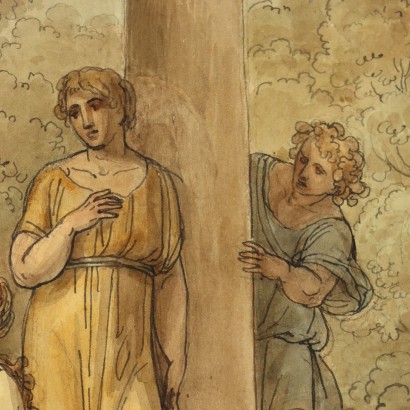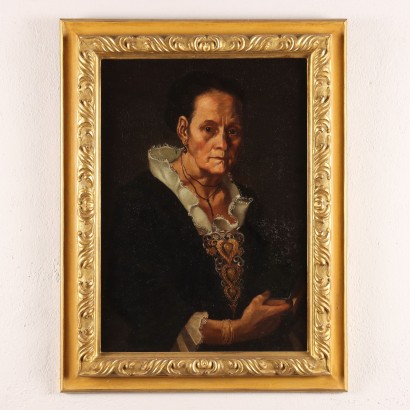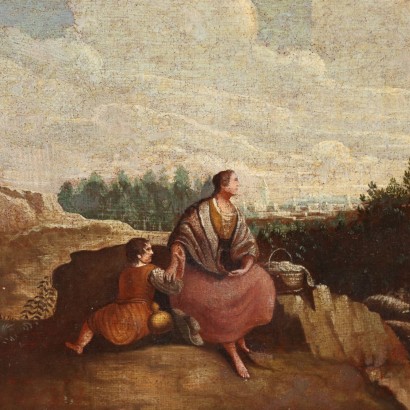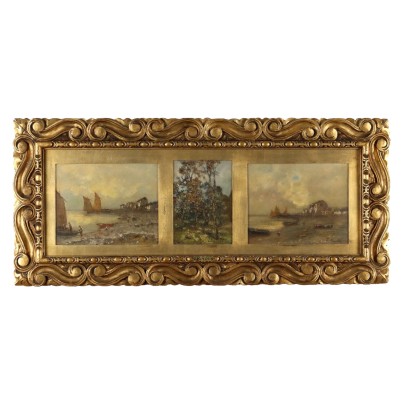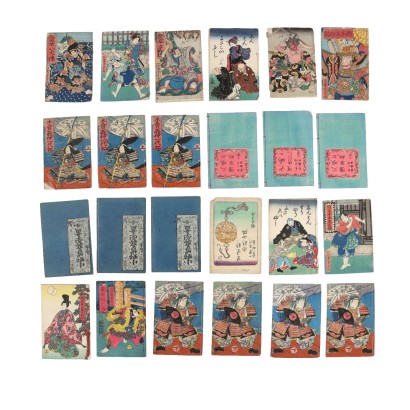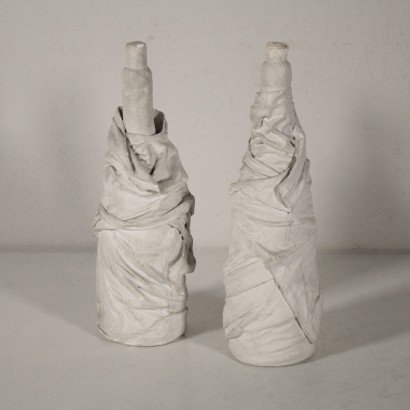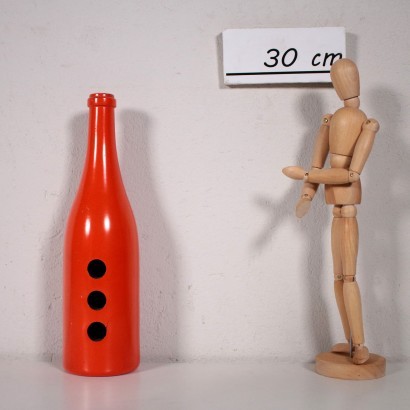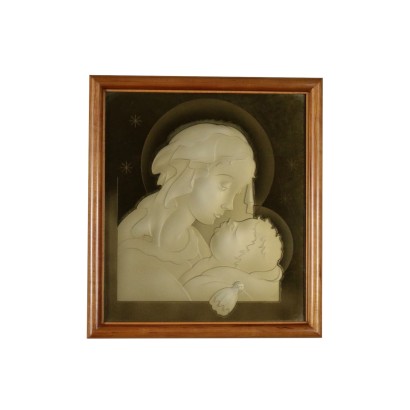G. Cades Attr. Watercolor on Paper Italy XVIII Century - A Sacrifice to Venus
Features
A Sacrifice to Venus
Artist: Giuseppe Cades (1750-1799) Attributed to
Artwork title: Scena di sacrificio a Venere.
Age: 18th Century / 1701 - 1800
Subject: Scene with Figures
Origin: Italy
Artistic technique: Painting
Technical specification: Watercolor
Description : Scena di sacrificio a Venere.
Watercolor on paper. At the bottom left the name Giuseppe Cades, Although on the back, in addition to the attribution, the title "The oath of the Vestal Virgin". A girl is offering garlands of flowers to the statue of the goddess Venus, traditionally painted in a discrete way. She's holding the veil with one hand to cover the loins. The other hand covers the breast and the head with the hair gathered and adorned with flowers. Behind the girl, a young woman watches the scene, while a third peers from behind the column of the temple: therefore it seems to be a scene of supplication to the goddess, asking her to favor the love of two young men: according to both Greek and Roman tradition, the young before the wedding woman devoted themselves to this goddess, which was considered as the protector of marriage and conjugal fidelity. The work seems to be very close to the production of Giuseppe Cades, who in the 1780s and 1790s became one of the best known and appreciated personality in the Roman artistic world. He was a draftsman and an engraver too. The work is framed
Product Condition:
Product in good condition, it has small signs of usage
Frame Size (cm):
Height: 47,5
Width: 38
Depth: 1,5
Artwork dimensions (cm):
Height: 40
Width: 31
Additional Information
Artist: Giuseppe Cades (1750-1799)
Roman painter, born in 1750, was a pupil of D. Corvi, under the influence of Mengs while tempering his rigid classicism with eclectic references to Raphael and Titian. His works are in the churches of Ascoli, Genoa, Rome, Urbino, Turin, etc. He decorated a ceiling in the casino of the Villa Borghese in Rome with the History of Count Gualtieri. He was also an engraver. In the decade 1780-90 he became one of the best known and most appreciated figures in the Roman artistic world.Age: 18th Century / 1701 - 1800
18th Century / 1701 - 1800Subject: Scene with Figures
Artistic technique: Painting
La pittura è l'arte che consiste nell'applicare dei pigmenti a un supporto come la carta, la tela, la seta, la ceramica, il legno, il vetro o un muro. Essendo i pigmenti essenzialmente solidi, è necessario utilizzare un legante, che li porti a uno stadio liquido, più fluido o più denso, e un collante, che permetta l'adesione duratura al supporto. Chi dipinge è detto pittore o pittrice. Il risultato è un'immagine che, a seconda delle intenzioni dell'autore, esprime la sua percezione del mondo o una libera associazione di forme o un qualsiasi altro significato, a seconda della sua creatività, del suo gusto estetico e di quello della società di cui fa parte.Technical specification: Watercolor
The watercolor or the watercolor is a painting technique that involves the use of pigments, finely ground and mixed with a binder, diluted in the water. The watercolor is a technique that is popular for its speed and for the easy portability of the materials, which have made it the technique of the excellence of those who paints and travelling in the open air. The support used for this technique is the paper that is preferably used with a high percentage of pure cotton as the long fiber of this plant do not change in contact with water. The paper that you buy commercially is measured in grams meter (weight of a sheet of 1 square meter). The preparation of the watercolor painting can be done according to three separate technical: 1) high level of overlapping, which, in addition to giving strength and tone to the same color, give the preparatory drawing, which is usually performed in light pencil, the necessary depth pictorial useful to the representation of the volumes, the shadows and the light; 2) painting wet-on-wet, i.e. the preparation of a coloured pigment to be made on the sheet of wet paper in the above so that the colors from spreading and flowing and giving you a look suffused the painting; 3)painting wet-on-dry, in which the pigment is laid after being dissolved with a sufficient amount of water to slide on the dry sheet.Other customers have searched:
Pittura antica, artisti italiani, pittura olio su tela, arte 800, pittura antica, arte novecento, oggetti d'arte, ritratto di signora, dipinto animali, quadro paesaggio montano, dipinto olio su tela, dipinto antico, dipinti natura morta, quadro antico, quadro del '600, pittori italiani quadri olio su tela paesaggi, paesaggio marino dipinto, paesaggio invernale dipinto, paesaggio autunnale dipinto, dipinto di paesaggio, arte antica, quadro religioso..
Se sei un appassionato d'arte, non perderti i nostri approfondimenti sul Blog Arte Di Mano in Mano e su FineArt by Di Mano in Mano - Arte:
Leggi di più
Ecco alcuni tra i principali articoli:
Vedute
Falsi nell'arte antica
Un messaggio di fiducia per ripartire
La potenza espressiva dell'arte figurativa etiope
Breve Storia del Collezionismo
Giorgio Upiglio, maestro dei libri d'artista
Matthias Withoos detto "Calzetta bianca"
San Rocco pensaci tu - Classic Monday
Dai un'occhiata alle nostre rubriche di divulgazione sull'arte:
Epoche
Lavorazioni e tecniche
Mostre ed Eventi
Protagonisti
Se sei appassionato di pittura antica, con tutta probabilità gusterai le schede di questi stupendi quadri:
"Dio parla a Noè dopo il diluvio", Jacopo da Ponte, detto il Bassano, seconda metà XVI secolo
Crocifissione, maestro della misericordia dell'accademia, terzo quarto del XIV secolo
Erminia incontra i pastori, Camillo Gavassetti, Seconda metà anni Venti del XVII Secolo
Eroine dell'antichità, Francesco Conti, XVIII secolo
Hieronymus III Francken, La Negazione di Pietro, XVII secolo
Jefte e la figlia, Girolamo Forabosco e aiuti, XVII secolo
L'Accademia di Platone, piccolo arazzo, fine XVII - inizio XVIII secolo
Maddalena e San Giovanni Battista
Natura Morta, Bartolomeo Arbotori, XVIII secolo
Sacra Famiglia con San Giovannino, Bartolomeo Ramenghi, scuola di, prima metà XVI secolo
Testa Femminile, Andrea del Sarto, ambito di, post 1522
Uva, fichi, melagrana e pesche su un capitello - Maximilian Pfeiler, primo quarto XVIII secolo
Sapevi che l'arte può essere anche un ottimo investimento (e non solo per grandi portafogli)?
L'Arte tra Collezionismo e Investimento
FineArt: Arte come investimento
Leggi di più
Ecco alcuni tra i principali articoli:Vedute
Falsi nell'arte antica
Un messaggio di fiducia per ripartire
La potenza espressiva dell'arte figurativa etiope
Breve Storia del Collezionismo
Giorgio Upiglio, maestro dei libri d'artista
Matthias Withoos detto "Calzetta bianca"
San Rocco pensaci tu - Classic Monday
Dai un'occhiata alle nostre rubriche di divulgazione sull'arte:
Epoche
Lavorazioni e tecniche
Mostre ed Eventi
Protagonisti
Se sei appassionato di pittura antica, con tutta probabilità gusterai le schede di questi stupendi quadri:
"Dio parla a Noè dopo il diluvio", Jacopo da Ponte, detto il Bassano, seconda metà XVI secolo
Crocifissione, maestro della misericordia dell'accademia, terzo quarto del XIV secolo
Erminia incontra i pastori, Camillo Gavassetti, Seconda metà anni Venti del XVII Secolo
Eroine dell'antichità, Francesco Conti, XVIII secolo
Hieronymus III Francken, La Negazione di Pietro, XVII secolo
Jefte e la figlia, Girolamo Forabosco e aiuti, XVII secolo
L'Accademia di Platone, piccolo arazzo, fine XVII - inizio XVIII secolo
Maddalena e San Giovanni Battista
Natura Morta, Bartolomeo Arbotori, XVIII secolo
Sacra Famiglia con San Giovannino, Bartolomeo Ramenghi, scuola di, prima metà XVI secolo
Testa Femminile, Andrea del Sarto, ambito di, post 1522
Uva, fichi, melagrana e pesche su un capitello - Maximilian Pfeiler, primo quarto XVIII secolo
Sapevi che l'arte può essere anche un ottimo investimento (e non solo per grandi portafogli)?
L'Arte tra Collezionismo e Investimento
FineArt: Arte come investimento



